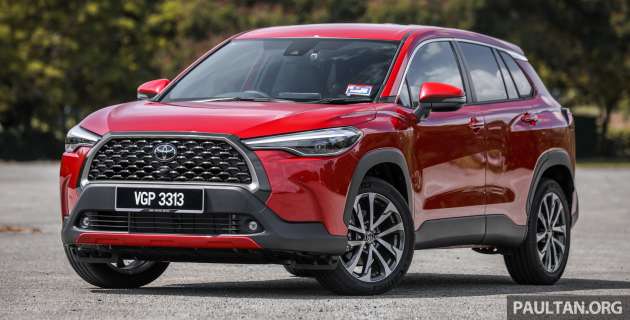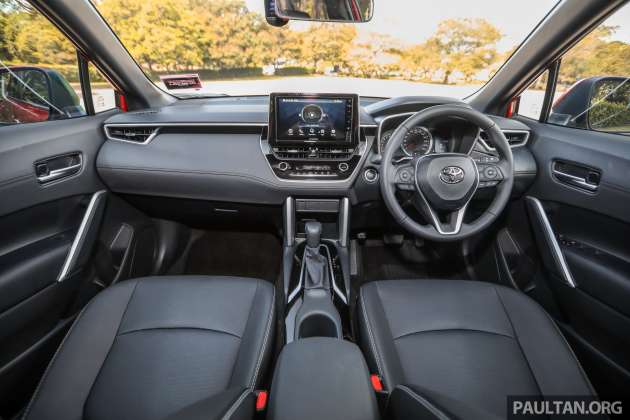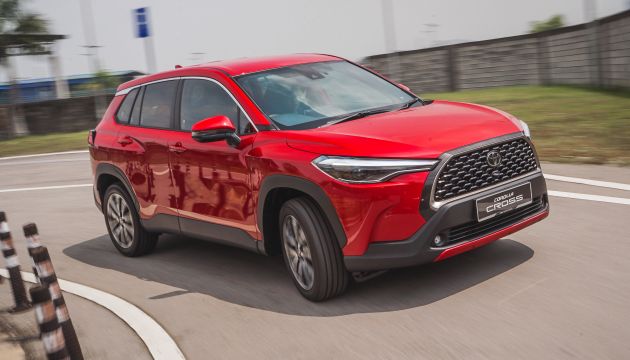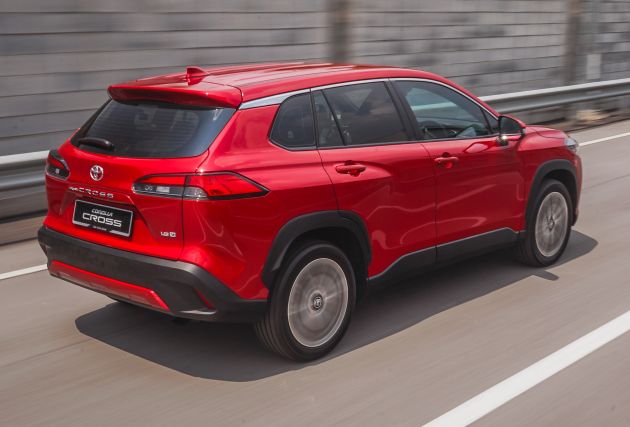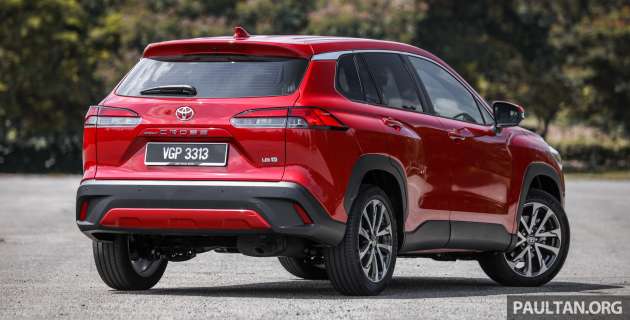Our first stint with the Toyota Corolla Cross took place a little over six months ago. At the time, we only spent the better part of two hours driving the entry-level 1.8G variant along the fringes of the state, which honestly wasn’t enough seat time to properly assess the car and provide you with the most meaningful insights.
When we learned of the 1.8V’s induction to UMW Toyota’s fleet, we had to give it a second go – that much is owed to you, our valued readers. This time, we spent close to a week with it, and let us tell you why it’s definitely worth the small premium over the 1.8G.
At RM129k, it only costs RM5,000 over the 1.8G
Just in terms of styling alone, the V already looks so much better than the G. Extras include bi-LED projector headlights, LED daytime running lights that double as turn indicators, larger 18-inch dual-tone alloy wheels, a nicer pair of LED combination tail lights, as well as a glass-covered front badge for the Toyota Safety Sense system.
These slightly premium touches really do elevate the look and feel of the crossover, but it’s still far from the best-looking one in its segment. We think the Taiwanese GR Sport variant and Japanese hybrid have a far more likeable front fascia, but this is what we’ll get for now. Like the 1.8G, it also gets a powered tailgate (with foot sensor), keyless entry system, and a 360-degree surround view camera.
Cabin appointments are pretty similar to the 1.8G
Save for a few additional buttons on the steering wheel for the ADAS system, the interior between the 1.8G and 1.8V is pretty much identical. There’s not much to get excited about, but what we really liked was how utterly breezy ingress and egress was.
The car sits at the perfect height, not too tall like full blown SUVs such as the Mazda CX-5, Honda CR-V and Proton X70, and not too low like a typical hatchback. This is especially beneficial for those with a limited range of mobility, plus the door apertures are wide enough for individuals to easily transition from wheelchairs or walkers, and vice versa.
While the cockpit may not reek of sophistication, it still feels quite solidly built. The steering wheel is almost identical to the one found in the Harrier, which feels premium to say the least. The only difference is the centre boss and bottom spoke design, but otherwise, the leather wrapping and switchgear tactility are top notch. All four windows also feature auto up-down functionality, a quality-of-life feature that somehow continues to elude most Honda cars, including the Accord.
During our first impressions drive, it was noted that the hard plastics used for the dashboard wasn’t done in good taste. While a soft touch material is still preferred, we do think the harder variety will be far more resistant to heat and UV exposure over, say, the next decade or two.
Leather seat upholstery with white contrast stitching is standard. The seats are plenty comfortable for long drives, although the front ones could use slightly better lower bolster support. We like the treatments done to the rear quarters – four cubby holes, twin centre air vents and 2.1A USB charging ports, two Isofix child seat anchors, and a 60:40 split configuration.
Now for the things that are not as nice. There is no electrochromic rear-view mirror nor LED map lights, but at least there are faint blue LED mood lighting along the doors. The nine-inch infotainment display is pleasantly responsive, but the overall user experience is a bit of a mixed bag.
To start, the 360-degree camera feed looks glaringly odd to the point of being useless, and there isn’t a dedicated “back” button that takes you back to the main screen, even after shifting into P. There is Apple CarPlay and Android Auto support, but you’ll have to plug your phone into the USB connection at the bottom right side of the display.
Yes, you’ll have to live with a dangling cable. In other markets, the port exists below the climate control console, which makes things that much tidier. Honda cars fare better in this regard, usually offering a lot more storage spaces along the centre tunnel. There’s no beating the Mazda CX-30‘s cockpit in terms of absolute build and perceived quality, but the upside is the Toyota is a tad more practical.
A six-speaker sound system is standard, but audio reproduction is mediocre at best. There’s only so much the custom equaliser can do to fix things.
Meanwhile, the 440 litres of boot space is class leading. It’s only slightly bigger than the Honda HR-V (437 litres), but the HR-V has magic seats, so it is definitely more practical if you’re always moving stuff instead of humans. Otherwise, the Corolla Cross is sufficient for most people.
TNGA is the real deal
As a daily urban runabout, the Corolla Cross is almost impossible to fault. It’s quite a bit bigger than the HR-V or Proton X50, yet it doesn’t feel intimidating to drive in and around old townships or city centres, where roads are narrow and parking lots are cramped. You won’t have to second guess your manoeuvres, too, assuming you’re competently spatially aware.
It’s also a very easy car to drive. The steering is light, the ride is comfortable, and the engine is very refined. In case you didn’t know, the 2ZR-FE 1.8 litre four-cylinder engine under the bonnet is the same one found in the Corolla sedan, developing 139 PS and 172 Nm of torque.
A continuously variable transmission (made by Aisin, maker of some of the best gearboxes in the world) is standard, and it has seven virtual ratios that very impressively mimics the gearshifts of a torque converter automatic. At low speeds, the engine feels very eager and responsive, a bit like the Myvi, but with more finesse and restraint.
That’s a good thing, because getting off the line feels easier, and the engine is silent for the most part. The numbers on paper may suggest some lethargy, but we don’t think it’s underpowered at all. In fact, it gets up to speed at a decent pace, and has enough “in-gear” grunt to swiftly overtake vehicles, even at 100 km/h.
After driving several Honda cars with Earth Dreams CVT, we find the Aisin CVT drone to be much more muted in comparison, so that was a pleasant surprise. As for the fuel consumption test, we managed an average of 6.7 litres per 100 km (or 15 km/l) on mixed driving conditions (mostly urban and extra urban), which is dang good considering that the car weighs 1.4 tonnes.
That puts it over 100 kg heavier than the HR-V, and though they both have a torsion beam rear suspension, the setup on the Corolla Cross feels better sorted and less primitive, if you will. Rebounds can at times feel stiff, but it’s nowhere near as crashy as the HR-V. Toyota aced the rear axle design here, and the fact that it rides on the stellar TNGA platform is a win for buyers.
Refinement is also very good – the 1.8V runs on 18-inch wheels wrapped with Michelin Primacy 4 tyres. Tyre roar on these are much less pronounced compared to the Bridgestone Alenzas on the 1.8G’s 17-inch hoops. Not much else in the way of noise are able to creep into the cabin, so this is probably class leading.
If the extra kit doesn’t justify the premium, then Toyota Safety Sense will
Over the course of our testing, the adaptive cruise control and lane centring assist worked flawlessly all the time. The steering, braking and acceleration assistance have a certain grace to it, without feeling alarmingly intrusive when kicking in. There’s a small amount of self-steering when cruising, but you’ll have to keep your hands on the wheel to prevent the system from being disabled.
It’s not Level 2 or semi-assisted self-driving yet, though. There’s no low speed follow function, and the lane tracing system isn’t the most advanced one yet. Otherwise, there’s autonomous emergency braking, seven airbags, tyre pressure monitoring system, automatic high beam assist, blind spot monitoring, and rear cross-traffic alert.
These are definitely nice add-ons over the 1.8G, which only get blind spot monitoring, rear cross-traffic alert, seven airbags, and 360-degree surround view camera.
Verdict
We don’t know what it is about the Corolla Cross, but there’s a strong sense of charm in the utility and ease of use that it offers. Personally, I kept looking for reasons to want to drive this car instead of the sedans at home. Call it ageing, but I really look forward to driving it every time – it’s just a great comfy cruiser.
The Corolla Cross’ arrival may be six years too late to take on the HR-V, but it’s no longer about fighting Honda. There is a real place for the Corolla Cross in this market. Some people find the CR-V, CX-5 and X70 too big and intimidating to drive around, and cars like the X50 or Subaru XV a touch too small for their liking. This is a solid middle ground.
The engine is responsive, it has a big boot, nice plush leather seats, a very refined cabin, and it’s the right size and height. It’s the little things that Toyota gets right, and we really do think it’s an easy car to recommend. Really, get the 1.8V over the 1.8G, because the small premium is just too good to pass on. As for the hybrid, well, let’s save that for another day.
Source: Read Full Article

